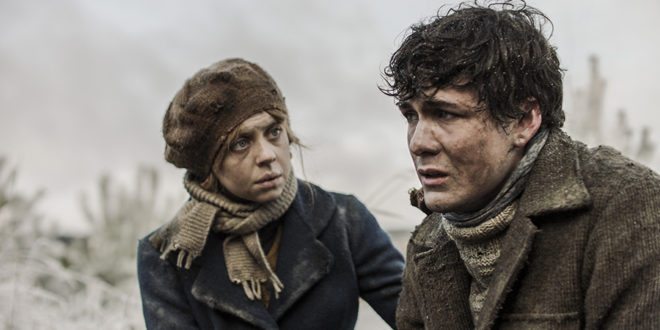Sandra Baksys.
The “biggest Lithuanian movie of all time” is set for worldwide release October 12, 2018. Filmed in accented English and some Russian with subtitles, Ashes in the Snow will tell the world the little-known story of the U.S.S.R.’s deportations of tens of thousands of innocent Lithuanians to their deaths in the frozen reaches of Siberia during and after World War II.

Ashes is the long-awaited feature film adaptation of The New York Times best-selling young adult historical novel, Between Shades of Gray, by Ruta Sepetys. The story centers on a 16-year-old Lithuanian girl whose family is exiled to Siberia during the first wave of Soviet deportations in June 1941. The film stars Gotham Award-winning actress Bel Powley (Diary of a Teenage Girl) and Martin Wallstrom (of the Golden Globe-winning TV series, Mr. Robot).
“There are so many cool moments and stories from the making of this film,” says director Marius Markevičius. “Most memorable for me was having this team of actors in the leading roles coming from so many different countries, from Norway, Sweden, Great Britain – all committing themselves to a project about Lithuania and the Baltics. Bel immersed herself by spending time in Lithuania and learning everything she could. A couple of the actors had to learn Russian for their roles.”
According to Markevičius, Ashes took 45 days to shoot at multiple locations in Lithuania, including Nida-Palanga and Vilnius. He explained that the film’s Lithuania-based cast is composed of Siberian deportation survivors and their descendants “to maximize the power of truthfulness and authenticity.”
First Global Feature Film about Lithuania in English
Markevičius predicts that Ashes in the Snow will be the first film that really puts Lithuania on the map and in the consciousness of people around the world. “This will be the first globally distributed major feature film in English about Lithuania, telling the story of one of the most seminal events of the country’s 20th century history,” he explains.
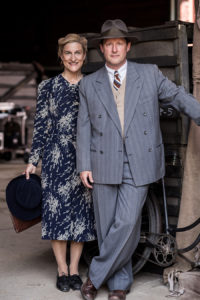
The seeds of that ambitious vision can be found in Markevičius’ 2012 documentary film with subtitles, The Other Dream Team, which told the story of newly independent Lithuania’s tie-dyed, post-Soviet return to Olympic basketball. (Previously, he did production work on the major Hollywood feature film, The Way Back, starring Ed Harris as a Siberian gulag prisoner who escapes to freedom by trekking across the wastelands of central Asia.)
Now, finally, with Ashes in the Snow, Markevičius and Ashes’ Lithuania-based producer, Žilvinas Naujokas, have mounted a Lithuanian scripted-narrative feature film that can cross borders into fully global distribution. Naujokas was lead producer of Tadas Blinda, the 2011 Lithuanian-language historical epic that broke Lithuanian box office records.
His Kaunas-based company, Acme Films, which has exclusive rights to distribute Warner Bros. and Sony Pictures films to cinemas in Lithuania, Latvia, and Estonia, will handle Ashes’ distribution in the Baltic countries.
Los Angeles-based Creative Artists Agency is arranging screenings and negotiating distribution agreements for North America and other markets. “They’re our international agent selling rights all over the world, piecing together this big, global puzzle,” Markevičius explains.
‘Indie’ Equals Authentic
For all this, Ashes in the Snow remains an independent film not produced or backed by a major Hollywood studio. But there is a good reason for that, according to Sepetys, with whom its story began. She said she optioned the movie rights for her book to Markevičius and Naujokas “because I wanted the movie to be authentic, not shot in Colorado with American actors like the big Hollywood studios wanted.”
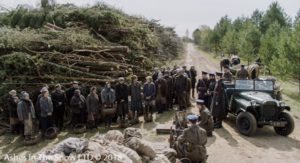
And thanks, first of all, to American screenwriter Ben York Jones, Sepetys says the film is “totally authentic” to her book. “The novel, the book, is there—and more,” she concluded, after reading the screenplay, viewing evolving cuts of the movie—and after having spent nine days on location in Lithuania, witnessing the filming of non-Siberian “summer flashback scenes” in Nida and her book’s emotional train station scene.
It is at the train station where families are torn apart and frightened men, women and children are packed into cattle cars with no idea of where they’re going, or whether they will survive. “The way the actual deportation scene was filmed, the people being herded and loaded—it was so emotional for me—just the injustice and indignity of it. Of course, I knew they (the film crew) would do a beautiful job capturing it.”
Violence Amped up From the Book
“Threads of violence and brutality cut from my original manuscripts because of the young audience—certain plot elements—ended up being restored in the screenplay,” Sepetys notes. “As Ben was writing the threads of the characters, he felt those scenes just needed to be included.”
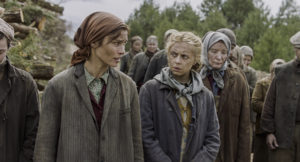
About bringing the Soviet violence the characters endured to life, Markevičius points out, “There’s a fine line between too much and too little. We didn’t want to go over the top in a way that would interrupt or distract from the arc of the story. But we also couldn’t whitewash what happened in those Siberian prison camps.
“So, there is violence and tragedy, including the scene of the newborn baby and mother taken straight from the hospital to a cattle car.…We don’t know what rating we will get. But even though the film is pretty mature, a very serious topic, we think it will be a PG-13 because we were still going for that wider audience.”
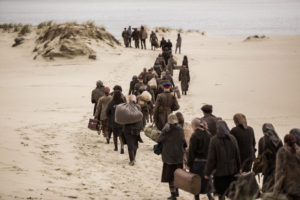
Sepetys says in three general audience test screenings followed by questionnaires (two screenings in the U.S. and one in Lithuania), “When we screened for students, they came out of the theater, hand on chest, saying, ‘OMG, I can’t believe this happened.’ But when I showed it to my father (whose own father’s cousins were deported and sent back letters from Siberia), first Dad said, ‘The film is better than your book. But I have to tell you, it (Siberia) was much worse than the film depicts.’”
Sepetys believes the same generational divide when it comes to knowledge about the brutality of the Siberian experience will be found in Lithuanian audiences. And she hopes the film will have the same benefits in educating the younger generation there as elsewhere around the world.
A Love Story Set in a Prison Camp
Complicating the job of writing and filming Ashes, Markevičius notes, was that, unlike most World War II films, “at its heart, this is a love story–not a typical WWII film laden with war scenes and military might. It’s very personal and interpersonal.

“But in a film, unlike in a book, you can’t get the love story by hearing the characters’ thoughts; you have to see it all. And it’s easy to cross the line to the melodramatic or over-romantic when you’re trying to capture what is essentially a love story set in a prison camp.”
One reason screenwriter Jones was chosen for the project was because of his work on the film, Like Crazy, the 2011 Sundance Grand Jury Prize winner that Markevičius produced (and more recently, the Netflix original series, Everything Sucks). “Ben just captures a young person’s experience really well, and this is the story of a young Lithuanian girl who has her life turned upside down and doesn’t know why.”
Another strand of “authenticity” that Sepetys agreed on with Markevičius and Naujokas was that the production of the film should go to Lithuania’s skilled motion pictures industry.
Lithuanian ‘Authenticity’
“All of the extras and some of the principal actors – the elderly people – were actual survivors deported as children. When you see these beautiful faces, they are the real survivors,” says Sepetys. “The rest are children or grandchildren of survivors.”
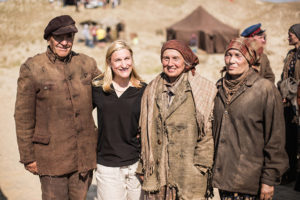
She continues, “The entire cinematography crew, the production designers, wardrobe, set building, costume and make-up crews, they were all Lithuanian. I am so anxious for the world to see the level of film production in Lithuania—it’s one of those best-kept secrets, but it shouldn’t be.”
Particularly in an independent film like Ashes, creating production value—bang for the buck—is an imperative. “The main goal,” Markevičius explains, “is to build what looks like a big, big budget movie for much less than the typical Hollywood $50-$100 million. And I was really pleased by the production value created by our Lithuanian team.”
As an example, he recalls arriving on the set of the movie’s faux Siberian prison camp, which incorporated abandoned industrial machinery and buildings from a shuttered sand mining operation outside Vilnius. “By the time I got there,” Markevičius says, “ten or 12 structures had already been built. They were primitive, and some were just facades, like on any Hollywood set. But the scope and the scale of the work was pretty incredible, beginning with architects’ sketches.
“The Lithuanian teams built it all beautifully. And we accomplished things we could not have accomplished shooting in the U.S.”
Deportees Re-Enact their Experience
Having the cast filled out by Lithuanian actors and extras who were either surviving deportees, or the descendants of deportees, also contributed authentic human factors unique to Lithuania. Both Sepetys and Markevičius consider those human factors critical to the film, in which Markevičius says, “We wanted to tap into the immense power of truthfulness.”

He adds, “It was pretty profound to see elderly people who were survivors, themselves, in these costumes and in these scenes, these long shoots in snow and cold that looked and felt like what they had been through.”
He concludes, “Not only were our Lithuanian crews skilled, but a lot of them had a connection to the Siberian experience. So, you could feel their heart and soul going into it from the top down, from the cinematographers to the extras and even the caterer. You could really feel it on the set, and that was very moving to me.”
Siberia on the Baltic
But where did the movie-makers find Siberia in Lithuania? On a February shoot hundreds of feet out on the 0.5-meter-thick ice covering the Kuršių Marios between the Curonian Spit and the Lithuanian mainland. “We filmed on the frozen sea—the coldest environment I ever worked in, as a guy born and raised in Los Angeles. From all our research, we thought it looked like a frozen tundra, like the Laptev Sea.
“It was pretty interesting to have our base camp out on the ice 50 feet or more from shore, where we had our tents set up and would bring things back and forth with ATVs. Then from our base camp, we would venture out hundreds of feet farther onto the ice to film where there would be no signs of civilization, to get everything authentic.

“We’d be wondering if all our people would be OK, and then we’d see a big truck with ice fishing supplies driving out there.”
Later, when 12 and 14-hours workdays on the ice gave way to a shoot at the labor camp set near Vilnius, just before a shoot, the heavy snow required for filming was melted by heavy rains and warming temperatures. “We had to use fake snow and digital effects in post-production to clean up areas that had melted away,” Markevičius recalls.
Also in post-production, 60 hours of film were pared down into a three-hour “rough cut,” which was edited, with the help of the aforementioned test screenings, into a film of about 100 minutes. Editors Veronika Jenet (Oscar- nominated for The Piano) and Jonathan Dillon (an editor for Fox, Warner Bros. and Lionsgate studios) focused on reducing the run time while “getting the flow of the story just right,” Markevičius explains.
English Stands in for Lithuanian
The choice of English as the language of the Lithuanian characters in the film was considered key for Ashes’ international marketability, and follows the model of English for Polish in the blockbuster Holocaust film, The Pianist, starring Adrien Brody. Language coaches helped Ashes’ lead actors learn to speak English with “an Eastern European accent,” Markevičius says. For Lithuanians speaking English in minor roles, that was no problem.
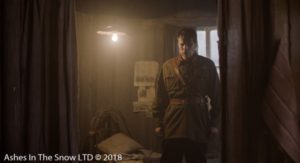
Russian is spoken by the actors playing Soviet authorities and guards and is subtitled, for authenticity’s sake. “Russian would have been a frightening foreign language for the Lithuanian deportees,” Markevičius says, “so we wanted the audience to see and share in that experience.”
There is one major scene where the Lithuanian national anthem is sung—in Lithuanian. Explains Markevičius, “I decided to depart from the rules for that scene because the national anthem is so important.
The prisoners in their cattle car feel their train is departing, and they don’t know whether it’s to their death, and they strike up and sing the anthem in unison.”
Lithuanian Government Support
As an indie, Ashes in the Snow had to rely on a creative mix of funding, including a grant from the Lithuanian Ministry of Culture. Other main sources of financing were private equity and Lithuanian-American investors who believe strongly in the importance of the film’s historical message, Markevičius explains.

He notes that the production also enjoyed a 20 percent rebate from the Lithuanian government, and the enthusiastic personal support of Lithuanian President Dalia Grybauskaitė.
As a gesture of thanks, Grybauskaitė and other officials visiting Washington, D.C., for the Baltic summit in early April were invited to a private screening. As part of a series of screenings for small and supportive audiences, Markevičius says Ashes in the Snow is also being shown at the Association for the Advancement of Baltic Studies Conference (AABS) in June at Stanford University.
After everything that has gone into the film, Markevičius concluded, “I am ready not to talk about it, but to show it.”

Adds Sepetys, “My overwhelming feeling about the film is still what drove me to write the novel, which is, ‘Why is this part of history not more well-known?’
“How in the world anyone survived this lottery of life or death in Siberia is truly a testament to the human spirit.”
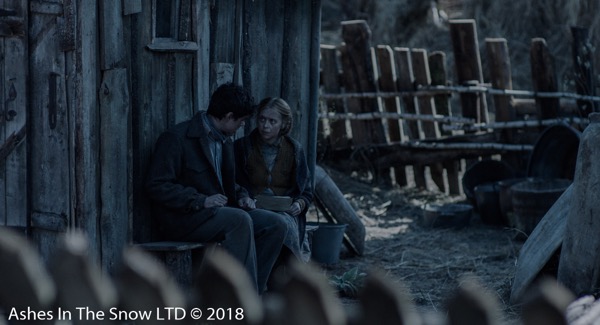
 DRAUGAS NEWS Lithuanian World Wide News in English
DRAUGAS NEWS Lithuanian World Wide News in English
